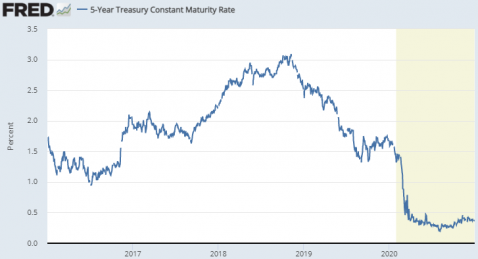
Yields on 5-year U.S. Treasury Notes continue to remain at lows reached as COVID slowed economic activity, driving rates lower. As can be seen in the chart above, these rates, most closely tracked for commercial real estate financing cost, remained near zero percent, closing at 0.36%, barely in excess of a third of a percent per year.
Borrowing costs have not followed this point for point, but suffice it to say that they’re lower. In deals where I’ve been involved, I’ve seen rates around 3%, perhaps a touch above, depending on the type of financing involved. Banks are being careful, however.
This low interest rate environment is a powerful force on real estate prices. There are of course ongoing concerns about vacancy rates and rent growth with a slower economy, but lower interest rates means lower debt service. Plus, real estate income becomes relatively more attractive to fixed income investments. Vacancy and rent growth effects remain unknown, but lower debt service is known.
The interest rate environment has the ability to affect commercial real estate values in a number of different ways.. Borrowing cost, i.e. debt service, is of course affected directly, as higher interest rates increase the cost of borrowing and thus negatively affecting demand. Cap rates tend move over time, but not always in the short term, in line with interest rates, with considered analyses generally concluding that cap rates move on average in the same direction as 10-year rates, but by about a third as much. Interest rates also affect the economy, which in turn affects vacancy and rental rates.
